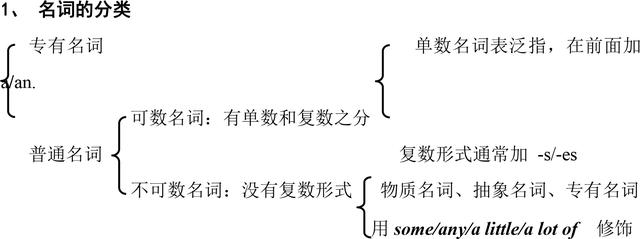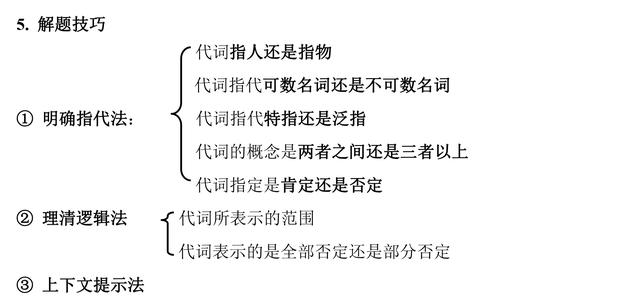中考语法整理名词

、 可数名词复数的变化形式
1) 规则变化
条件 | 变化 | 例词 | 注意 |
一般情况下 | 在词尾加-s | book → books cat → cats | |
-s , -x,-ch , -sh 结尾的名词 | 在词尾加-es | glass → glasses box → boxes watch → watches brush →brushes | ch 结尾的名词,在单词中发音为[k]时,其复数加-s. stomach → stomachs |
部分以-f-fe 结尾的名词 | -f / - fe 改为 –v 再加-es | self → selves thief → thieves knife →knives life → lives wolf → wolves | 特殊情况: roof → roofs scarf → scarfs belief →beliefs |
辅音字母+ -y结尾的名词 | -y改为– i 再加 –es | baby → babies story → stories country→ countries party → parties | 元音字母+ -y结尾的名词 在-y 后面直接加-s boy → boys day → days |
部分以辅音字母+ -o结尾的名词 | 词尾加 -es | potato → potatoes tomato→ tomatoes hero → heroes | 特殊情况: radio → radios piano → pianos zoo → zoos photo → photos |
2) 不规则变化
变化 | 例子 | 注意 | |
元音字母发生变化 | -a改为-e | man → men woman → women policeman→ policemen | German →Germans human → humans |
-oo 改为 -ee | foot → feet tooth → teeth goose → geese | ||
单复同形 | sheep → sheep deer → deer fish → fish chicken → chicken | chicken 鸡肉、fish 鱼肉,是不可数名词. 强调“种类”= fishes “小鸡”= chickens | |
有些名词常以复数形式出现 | trousers, socks, gloves, glasses, shoes | 要表达他们的量,常借助 pair. A pair of trousers Two pairs of gloves | |
表示”某国人” | 单复同形 | a Chinese → two Chinese a Japanese → two Japanese | |
词尾加-s | a German → two Germans an American→two Americans | ||
man→men | an Englishman→ two Englishmen an Frenchman→ two Frenchmen | ||
其他形式 | child → children ox → oxen mouse → mice |
注意:
① 有些名词以-s结尾,但表达单数意义。
科学名词:physics, mathematics/maths 游戏名称:bowls
专有名词:the United States, Niagara Falls 其他名词:news, falls
② 名词做定语,不用复数形式.
e.g. a shoe shop, an apple tree
*例外:man, woman作定语时,如果后面的名词是复数,则man, woman也要变。
e.g. a woman teacher → three women teachers
a man doctor → many men doctors
③ people, police做“人们”讲时,看作复数,不能在后面加”-s”, 谓语动词用复数形式。family, class是集体名词,既指单数,又指复数,谓语动词可用单数亦可用复数,具体根据语境而定。
④ 不可数名词:一般指物质名词、抽象名词和专有名词,通常没有复数, 其前不用冠词a/an或数词,但可用much, a little, a lot of/lots of, some, any的等修饰。
Exercises:
—Look at the clouds, so beautiful!
—Wow, so many different _______, horses, sheep, flowers…
A. sizes B. shapes C. colors D. styles
There are some _______ in Dayton Art Museum. For example, no food or drink is allowed inside.
A. jobs B. records C. rules D. paintings
—Yesterday, my father bought me a new mobile phones as a present, but I don’t know how to use it.
—Why not read the _______ first before using it?
A. expressions B. applications C. advertisements D. instructions
These _________ have saved many children’s lives.
A. woman doctors B. women doctor
C. women doctors D. woman doctor
---What would you like to drink, _______or orange? ---Orange, please.
A. hamburger B. chip C. tea
3、 不可数名词的数
1) 可以修饰不可数名词的词或短语:a lot of , lots of, some, a little, little
2) 数词+ 量词 + of + 不可数名词
e.g. a glass of water → two glasses of water
a cup of tea → three cups of tea
3) 常用的不可数名词
food, meat, fish, chicken, pork, beef, mutton, orange, milk, tea, coke, water, rice, bread, homework, news, paper, ice, rain, snow, wind, cloud, air, weather, maths,Chinese, English, music, information, fun, work 等.
4) 有些不可数名词以复数形式出现时,意思有变化.
单数形式 | 复数形式 | 单数形式 | 复数形式 | ||||
work | 工作 | works | 著作 | water | 水 | waters | 水域 |
time | 时间 | times | 时代 | good | 好处 | goods | 商品、货物 |
light | 光 | lights | 电灯 | sand | 沙子 | sands | 沙滩 |
wood | 木头 | woods | 树林 | cloth | 布 | cloths | 衣服 |
glass | 玻璃 | glasses | 眼镜 | snow | 雪 | snows | 积雪 |
manner | 举止 | manners | 礼貌 |
5) 有些名词,既可以作可数名词,又能做不可数名词,但含义不同
英语 | 可数名词 | 不可数名词 |
beauty | 美人 | 美丽 |
life | 生命,生活 | 性命,人名 |
orange | 橘子 | 橘汁,橘黄色 |
paper | 报纸,论文,试卷 | 纸 |
Exercises:
—Mum, I’ve heard that we can’t eat ____ those days. Is it true?
—Take it easy. It is safe to eat cooked meat.
A. chicken B. chickens C. a chicken D. the chicken
The students of Grade 7 visited Mike’s farm and saw many ___ there.
A. bird B. duck C. sheep D. rabbit
I’m so hungry. Please give me ___ to eat.
A. three bread B. three pieces of bread C. three pieces of breads D. three piece of bread
I want a sweet milk. Put some ______ in my cup, please.
A. ice B. soup C. salt D. sugar
—What a good ______ you’ve given me! Thanks a lot. —My pleasure.
A. information B. news C. suggestion D. advice
4、 名词的所有格
分类 | 构成方法 | 例子 |
表示有生命的名词所有格 | 在单数后面加-’s | The teacher’s office Lily’s photo |
以加-s的复数名词后加“’” | The teachers’ office Boys’ games | |
不以-s 结尾的复数名词后加“-’s” | The children’s palace. | |
用and 连接两个并列的单数名词表示共有时,在后一个词尾加-’s;如果不是,则需要分别加在两个名词后面。 | Lily and Lucy’s house is big. Lily’s and Lucy’s houseare big. | |
表示无生命的名词所有格 | 一般用 “of + 名词” | The doors of our class. The color of the cover. The capital of China. |
注意:
①店铺、医院名称加’s, e.g. at the doctor’s
someone, everybody, no one和else, 在else后加’s, e.g.somebody else’s pencil
②双重所有格 : 当表示所有格的名词前有冠词、数词、不定代词或指示代词时,常用
“名词+of+'s”形式,这种结构被称为双重所有格,一般表示“所有关系”。
a novel of Lu Xun's鲁迅所有小说中的一本
the large house of Tom's汤姆的那栋大房子
that bag of Mary's玛丽的那个包
a few friends of Mr Wang's王先生的几个朋友
注意区别
a picture of my brother's我弟弟所有照片中的一张
a picture of my brother一张我弟弟的照片
Exercises:
Tomorrow I’m going to my ____. It’s a _______.
A. aunt ; five minutes’ walk B. aunt’s ; five minute’s walk
C. aunt ; five minute’s walk D. aunt’s ; five minutes’ walk
This is _________ bedroom. The twin sisters like it very much.
A. Anne and Jane B. Anne’s and Jane’s
C. Anne’s and Jane D. Anne and Jane’s
Near our school there are two ______.
A. shoes shops B. shoes shop C. shoe shops
5、常考易错点
① 名词同义辨析法
清楚不同的名词所表达的具体含义,并且能辨析它们之间的一些差异.
home , family , house 家
problem(主观的疑虑,疑问) , question(指客观存在和遇到的问题) , trouble(“麻烦,问题”,指客观的并棘手的)问题
clothing (不可数名词),clothes(没有单数形式的复数名词), dress(用作可数名词不指男人穿的) 衣服
job(强调工作的性质或工种,为可数名词) , work (不可数名词,含义更广)工作
sound(范围广,大自然的都可以用它) , voice (指人的,说话、唱歌),noise (嘈杂声)声音
people(指集体,复数) ,person(指个体,为单数),human(人类) 人
② 常见名词短语
名词的固定搭配是中考英语试题中考查的一个重要方面,所以牢固地掌握一些固定的短语或搭配,对于解答试题是很重要的。如:
tooth brush牙刷 lunch room午餐室 shoe store鞋店 school gate校门口
summer camp夏令营 night school夜校 street light路灯 country music乡村音乐
flower bed花坛 paper tiger纸老虎 maths teacher数学教师 boyfriend男朋友
clothes shop服装店 sports meet运动会 goods train货车 arts festival艺术节
③名词转化
某些名词后加y变形容词,表示“充满„的”,cloud-cloudy, sun-sunny
某些名词后加ful变形容词,表示“性质的”,use-useful, care-careful
部分表示人的名词后加ly变形容词,具有赞美意味。Friend-friendly, lovely
某些名词后加less表示没有,careless, useless
代词
1、代词的分类
数 分类 | 单数 | 复数 | |||||||
人称代词 (代替人或物) | 主格 | I | you | he | she | it | we | you | they |
宾格 | me | you | him | her | it | us | you | them | |
物主代词(表示所有关系) | 形容词性 | my | your | his | her | its | our | your | their |
名词性 | mine | yours | his | hers | its | ours | yours | theirs | |
反身代词 | myself, yourself, himself, herself, itself | ourselves, yourselves, themselves | |||||||
指示代词 | This, that | These, those | |||||||
不定代词(笼统的表示人或物) | some, any, all, every, each, both, another, one, none, any, much, few, little, something, anything, everything, nothing, somebody, everybody, nobody, someone, anyone | ||||||||
疑问代词 | who(whom), whose, what, which | ||||||||
关系代词 | who(whom), whose, that, which | ||||||||
相互代词 | each, other, one another |
2、 代词it 的用法
1) 指代前面提到过的事物
This is my book. It is Jim’s.
2) 代替指示代词 this 或 that
e.g. —What’s this? —It’s a pen
3) 表示时间、天气或季节
e.g. —What’s the time now? —It’s ten o’clock.
4) 表示距离
How far is it from your school to your home?
5) it 的常用句型
① it's + adj. +for/of sb. to do sth.
It was really kind of you to help me . (表示人的性格、品质clever, kind等的形容词,用of sb.)
It is important for us to work hard. (修饰事物easy, important的形容词,用 for sb.)
② It’s time to do/for/that…到该做…的时间了
It’s time to get up. 该起床了
It’s time for lunch. 吃午饭了
③ It seems that… 看起来好像…
④ It’s one’s turn to do sth. 轮到某人做某事
⑤ It’s + adj. + that从句
It’s necessary that you should present at the meeting.
3. 反身代词
① 反身代词的用法
e.g. This boy is too young to take care of himself.
The children made model planes themselves.
② 反身代词的常用词组
_____________/________________ 自学 _____________ 过得愉快
_____________ 自用、自取(事物,饮料等),请自便 _____________ 苏醒过来
_____________ 受伤 _____________ 独自,单独
对应训练:
The iPad is isn’t ____. It’s belongs to ____.
A. he ; me B. hers ; mine C. his ; me D. her ; mine
The man called his professor for help because he couldn’t solve the problem ____.
A. herself B. himself C. yourself D. themselves
The dictionary is not ____. Maybe it’s Tom’s. He is looking for____.
A. my ; him B. mine ; his C. us ; ours D. our ; our
---Why don’t you go to the lecture-room and listen to the talk?
---I hear there isn’t in it.
A. something new B. new anything C. anything new D. nothing new
—Who’s that speaking?—_________________.
A. This is Jack speaking B.I am JackC. Jack is meD.I am Jack
Miss Liu asked Tom to read the new words and students to listen to him.
A. other B. the others C. others D. the other
4、 易混点梳理
1) a few, few, a little, little
表肯定 (一点儿,几个) | 表否定 (几乎没有) | 后加名词 |
a little | little | 不可数名词 |
A few | few | 可数名词 |
2) either、neither、 both、 all 、none 、any
词 | 用法 | 例子 |
either | 两者中的每个、各方 | There are trees on either side of the street. |
neither | 两者都不 | Neither of the books is good. |
both | 两者都,both…and… | Both she andI are student. |
none | 三者或三者以上都不 | I know none of them. |
all | 三者或三者以上都 | All of us should go there. |
any | 三者或三者以上中的任何一个 | —Which do you like best, tea, coffee or water? —Any. |
3) other、the other、another、others、the other
用法 | 代词 | 形容词 | ||
单数 | 复数 | 单数 | 复数 | |
不定 | Another 另一个 | Others别的/其他的人或物 | Another (boy) 另一个(男孩) | Others (boys) 其他男孩们 |
特定 | The other 另一个 | The others 其余那些人或物 | The other(boy) 另一个男孩 | the other (boys) 其余那些男孩 |
4) each、every
词 | 用法 | 例句 |
each | 表”每个”,强调个体,谓语动词用第三人称单数。指两个或两个以上的人或事。 | There are trees on each side of the road. Each of us wears a yellow T-shirt. |
every | 表”每一个”,强调整体,谓语动词用第三人称单数。指三个或三个以上的人或事。 | Every student passed the exam. |
5) none, nothing, no one
词 | 用法 | 例句 |
none | 指人指物 | There are five people over there. I know none of them. |
nothing | 指事物 | She knew nothing about it. |
no one | 指人 | —Did anyone come to see you? —No one. |
6) it, one 与that作代词时的区别
词 | 用法 | 例句 |
it | 指代上文提到的同一事物 | The book is mine. It’s very interesting. |
one | 泛指上文提到的同类事物中的一个,同类而不同物。 | —Who has a pen? —I have one. |
that | 常用于比较级结构中,代替前面提到的名词,以免重复 | The weather in Beijing is colder than thatin Guangzhou in winter. |
7) no 与not的区别
no 只作定语,等于not a 或者not any。
e.g. I have no pencil. = I have not a pencil.
She has no friends in Jiangmen. = She has not any friends in Jiangmen.
在标语中,一般用no而不用not。
No smoking / No pets
对应训练:
1.—We have five kinds of schoolbags. Do you like this one?
—Can you show me ____?
A. another B. each one C. the other D. others
2.—There is ____ milk in the fridge. Please buy some on your way home.
— All right.
A. much B. many C. little D. few
3.There are many trees on ____ sides of the street.
A. both B. all C. each
4.There are six MP3 players in the box. Two are made in Japan and ___ are made in china.
A. other B. the others C. another D. others
5. ---Have you finished your work yet?
---No,not yet. I think it’ll take _____ ten minutes.
A.another B.other C.others D.more

 加载中,请稍侯......
加载中,请稍侯......
精彩评论